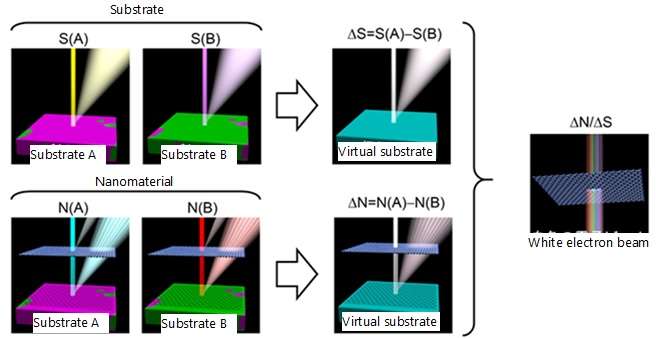Diagrams illustrating the working principle of the four-point probe technique using a spectroscopic microscope. Credit: National Institute for Materials Science
NIMS researchers Bo Da (researcher at the RCAMC and the CMI2, MaDIS) and Hideki Yoshikawa (leader of the Surface Chemical Analysis Group) and a research group led by Shigeo Tanuma (NIMS Special Researcher), Kazuhito Tsukakoshi (MANA Principal Investigator, NIMS), Kazuyuki Watanabe (Professor, Tokyo University of Science) and Zejun Ding (Professor, University of Science and Technology of China) jointly developed versatile spectroscopic microscopy techniques capable of simultaneously measuring a nano-thin film at a wide range of electron energy levels, from almost zero energy to high energy, using a microscope employing electron beams. The group also demonstrated the effectiveness of the technique.
Conventional methods of measuring nano-thin films require great care because they require changing the energy level of a monochromatic incident electron beam and readjusting the electron optical system while measuring the electron microscope image. We addressed this issue using a creative approach. We developed a new measurement technique using secondary electrons―which are generated in a substrate material and have a wide energy distribution―as a virtual white electron probe. To reduce this technique to practice, we needed to completely eliminate background signals from secondary electrons. We adopted the four-point probe method used in astronomy to accurately detect weak signals captured by telescopes. This method enabled us to simultaneously measure the electron transmittance of graphene at a wide range of energy levels between almost zero and 600 electron volts. We then confirmed that the measured values matched well with theoretical values. This study reports for the first time that information on the properties of a material ―specifically, the electron transmittance of nano-thin films―can be extracted from secondary electron signals.
Measurement of the transmittance characteristics of a material using visible light of various energy levels is analogous to identifying the color of the material. Similarly, measurement of the electron transmittance of a nano-thin film using electrons of various energy levels is analogous to identifying the color of a localized area of the film using a more narrowly focused "eye" (electrons). It is difficult to quickly determine the quality (e.g., color) of nano-thin films at specific target sites, as the film itself is normally difficult to locate. Accordingly, techniques such as the one developed in this study will be very valuable in research on new nano-thin films in which the qualitative consistency of the film across a large area needs to be ensured.
More information: Bo Da et al. Virtual substrate method for nanomaterials characterization, Nature Communications (2017). DOI: 10.1038/ncomms15629
Journal information: Nature Communications
Provided by National Institute for Materials Science























